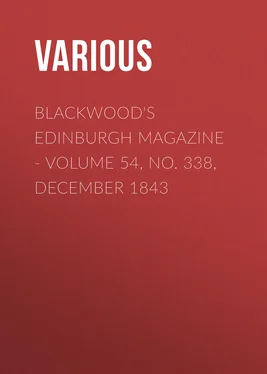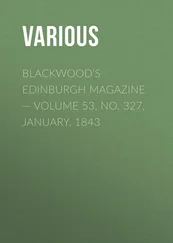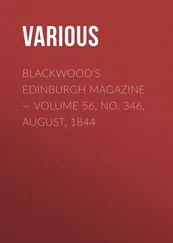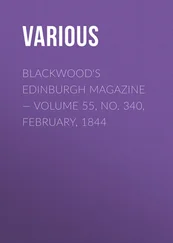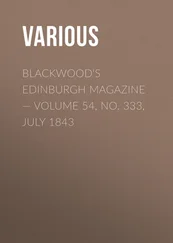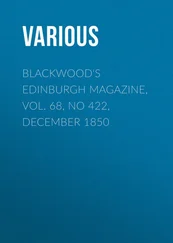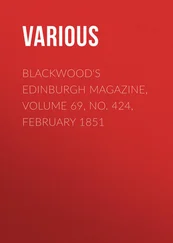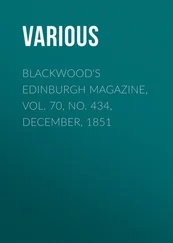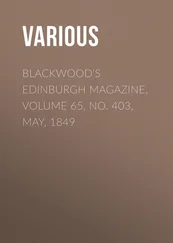Various - Blackwood's Edinburgh Magazine - Volume 54, No. 338, December 1843
Здесь есть возможность читать онлайн «Various - Blackwood's Edinburgh Magazine - Volume 54, No. 338, December 1843» — ознакомительный отрывок электронной книги совершенно бесплатно, а после прочтения отрывка купить полную версию. В некоторых случаях можно слушать аудио, скачать через торрент в формате fb2 и присутствует краткое содержание. Издательство: Иностранный паблик, Жанр: foreign_antique, periodic, foreign_edu, на английском языке. Описание произведения, (предисловие) а так же отзывы посетителей доступны на портале библиотеки ЛибКат.
- Название:Blackwood's Edinburgh Magazine - Volume 54, No. 338, December 1843
- Автор:
- Издательство:Иностранный паблик
- Жанр:
- Год:неизвестен
- ISBN:нет данных
- Рейтинг книги:3 / 5. Голосов: 1
-
Избранное:Добавить в избранное
- Отзывы:
-
Ваша оценка:
- 60
- 1
- 2
- 3
- 4
- 5
Blackwood's Edinburgh Magazine - Volume 54, No. 338, December 1843: краткое содержание, описание и аннотация
Предлагаем к чтению аннотацию, описание, краткое содержание или предисловие (зависит от того, что написал сам автор книги «Blackwood's Edinburgh Magazine - Volume 54, No. 338, December 1843»). Если вы не нашли необходимую информацию о книге — напишите в комментариях, мы постараемся отыскать её.
Blackwood's Edinburgh Magazine - Volume 54, No. 338, December 1843 — читать онлайн ознакомительный отрывок
Ниже представлен текст книги, разбитый по страницам. Система сохранения места последней прочитанной страницы, позволяет с удобством читать онлайн бесплатно книгу «Blackwood's Edinburgh Magazine - Volume 54, No. 338, December 1843», без необходимости каждый раз заново искать на чём Вы остановились. Поставьте закладку, и сможете в любой момент перейти на страницу, на которой закончили чтение.
Интервал:
Закладка:
"About the middle of the last century the German critics, established at Rome, began to claim the exclusive privilege of teaching the art, and to form a complete system of antique style. The verdicts of Mengs and Winkelmann, become the oracles of antiquaries, dilettanti, and artists, from the Pyrenees to the utmost north of Europe, have been detailed, and are not without their influence here. Winkelmann was the parasite of the fragments that fell from the conversation or the tablets of Mengs—a deep scholar, and better fitted to comment on a classic than to give lessons on art and style, he reasoned himself into frigid reveries and Platonic dreams on beauty. As far as the taste or the instruction of his tutor directed, he is right when they are; and between his own learning and the tuition of the other, his history of art delivers a specious system, and a prodigious number of useful observations." "To him Germany owes the shackles of her artists, and the narrow limits of their aim." Had Fuseli lived to have witnessed the "revival" at Munich, he would have appreciated the efforts made, and still making, there. He speaks of the works of Mengs with respect. "The works of Mengs himself are, no doubt, full of the most useful information, deep observation, and often consummate criticism. He has traced and distinguished the principles of the moderns from those of the ancients; and in his comparative view of the design, colour, composition, and expression of Raffaelle, Correggio, and Tiziano, with luminous perspicuity and deep precision, pointed out the prerogative or inferiority of each. As an artist, he is an instance of what perseverance, study, experience, and encouragement can achieve to supply the place of genius." He then, passing by all English critics preceding Reynolds, with the petty remark, that "the last is undoubtedly the first," says—"To compare Reynolds with his predecessors, would equally disgrace our judgment, and impeach our gratitude. His volumes can never be consulted without profit, and should never be quitted by the student's hand but to embody, by exercise, the precepts he gives and the means he points out." It is useful thus to see together the authorities which a student should consult, and we have purposely characterized them as concisely as we could, in our extracts, which strongly show the peculiar style of Mr Fuseli. If this introduction was, however, intended for artists, it implies in them a more advanced education in Greek and Latin literature than they generally possess. Mr Fuseli was himself an accomplished scholar. How desirable is it that the arts and general scholarship should go together! The classics, fully to be enjoyed, require no small cultivation in art; and as the greater portion of ancient art is drawn from that source, Greek mythology, and classical history and literature, such an education would seem to be the very first step in the acquirements of an artist. We believe that in general they content themselves with Lempriere's Dictionary; and that rather for information on subjects they may see already painted, than for their own use; and thus, for lack of a feeling which only education can give, a large field of resources is cut off from them. If it be said that English literature—English classics, will supply the place, we deny it; for there is not an English classic of value to an artist, who was not, to his very heart's core, embued with a knowledge and love of the ancient literature. We might instance but two, Spenser and Milton—the statute-books of the better English art—authors whom, we do not hesitate to say, no one can thoroughly understand or enjoy, who has not far advanced in classical education. We shall never cease to throw out remarks of this kind, with the hope that our universities will yet find room to foster the art within them; satisfied as we are that the advantages would be immense, both to the art and to the universities. How many would then pursue pleasures and studies most congenial with their usual academical education, and, thus occupied, be rescued from pursuits that too often lead to profligacy and ruin; and sacrifice to pleasures that cannot last, those which, where once fostered, have ever been permanent!
The First Lecture is a summary of ancient art—one rather of research than interest—more calculated to excite the curiosity of the student than to offer him any profitable instruction. The general matter is well known to most, who have at all studied the subject. Nor have we sufficient confidence in any theory as to the rise and growth of art in Greece, to lay much stress upon those laid down in this lecture. We doubt if the religion of Greece ever had that hold upon the feelings of the people, artists, or their patrons, which is implied in the supposition, that it was an efficient cause. A people that could listen to the broad farce of Aristophanes, and witness every sort of contempt thrown upon the deities they professed to worship, were not likely to seek in religion the advancement of art; and their licentious liberty—if liberty it deserved to be called—was of too watchful a jealousy over greatness of every kind, to suffer genius to be free and without suspicion. We will not follow the lecturer through his conjectures on the mechanic processes. It is more curious than useful to trace back the more perfect art through its stages—the "Polychrom," the "Monochrom," the "Monogram," and "Skiagram"—nor from the pencil to the "cestrum." Polygnotus is said to be the first who introduced the "essential style;" which consisted in ascertaining the abstract, the general form, as it is technically termed the central form. Art under Polygnotus was, however, in a state of formal "parallelism;" certainly it could boast no variety of composition. Apollodorus "applied the essential principles of Polygnotus to the delineation of the species, by investigating the leading forms that discriminate the various classes of human qualities and passions." He saw that all men were connected together by one general form, yet were separated by some predominant power into classes; "thence he drew his line of imitation, and personified the central form of the class to which his object belonged, and to which the rest of its qualities administered, without being absorbed." Zeuxis, from the essential of Polygnotus and specific discrimination of Apollodorus, comparing one with the other, formed his ideal style. Thus are there the three styles—the essential, the characteristic, the ideal.
Art was advanced and established under Parrhasius and Timanthes, and refined under Eupompus, Apelles, Aristides, and Euphranor. "The correctness of Parrhasius succeeded to the genius of Zeuxis. He circumscribed the ample style, and by subtle examination of outline, established that standard of divine and heroic form which raised him to the authority of a legislator, from whose decisions there was no appeal. He gave to the divine and heroic character in painting, what Polycletus had given to the human in sculpture by his Doryphorus, a canon of proportion. Phidias had discovered in the nod of the Homeric Jupiter the characteristic of majesty, inclination of the head . This hinted to him a higher elevation of the neck behind, a bolder protrusion of the front, and the increased perpendicular of the profile. To this conception Parrhasius fixed a maximum; that point from which descends the ultimate line of celestial beauty, the angle within which moves what is inferior, beyond which what is portentous. From the head conclude to the proportions of the neck, the limbs, the extremities; from the Father to the race of gods; all, the sons of one, Zeus; derived from one source of tradition, Homer; formed by one artist, Phidias; on him measured and decided by Parrhasius. In the simplicity of this principle, adhered to by the succeeding periods, lies the uninterrupted progress and the unattainable superiority of Grecian art."
Читать дальшеИнтервал:
Закладка:
Похожие книги на «Blackwood's Edinburgh Magazine - Volume 54, No. 338, December 1843»
Представляем Вашему вниманию похожие книги на «Blackwood's Edinburgh Magazine - Volume 54, No. 338, December 1843» списком для выбора. Мы отобрали схожую по названию и смыслу литературу в надежде предоставить читателям больше вариантов отыскать новые, интересные, ещё непрочитанные произведения.
Обсуждение, отзывы о книге «Blackwood's Edinburgh Magazine - Volume 54, No. 338, December 1843» и просто собственные мнения читателей. Оставьте ваши комментарии, напишите, что Вы думаете о произведении, его смысле или главных героях. Укажите что конкретно понравилось, а что нет, и почему Вы так считаете.
